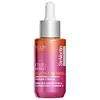What's inside
What's inside
 Key Ingredients
Key Ingredients

 Benefits
Benefits

 Concerns
Concerns

 Ingredients Side-by-side
Ingredients Side-by-side

Water
Skin ConditioningSodium Ascorbyl Phosphate
AntioxidantGlycereth-7 Triacetate
EmollientPentylene Glycol
Skin ConditioningPolysorbate 20
EmulsifyingDipropylene Glycol
HumectantGlycerin
HumectantDimethyl Isosorbide
SolventAscorbyl Glucoside
AntioxidantAscorbic Acid
AntioxidantMalpighia Glabra Fruit Juice
Skin ConditioningRetinol
Skin ConditioningSodium Hyaluronate
HumectantMyristyl Nicotinate
Skin ConditioningTamarindus Indica Seed Polysaccharide
Skin ConditioningOrobanche Rapum Extract
Skin ProtectingMalus Domestica Fruit Cell Culture Extract
Skin ConditioningCamellia Sinensis Leaf Extract
AntimicrobialXylitylglucoside
HumectantBacillus/Sea Salt Ferment Filtrate
Skin ConditioningHydroxymethoxyphenyl Decanone
Skin ConditioningAnhydroxylitol
HumectantAdenosine
Skin ConditioningXylitol
HumectantGlucose
HumectantEthylhexylglycerin
Skin ConditioningLecithin
EmollientXanthan Gum
EmulsifyingAcrylates/C10-30 Alkyl Acrylate Crosspolymer
Emulsion StabilisingPropanediol
SolventMaltodextrin
AbsorbentRhizobian Gum
Mica
Cosmetic ColorantParfum
MaskingLimonene
PerfumingLinalool
PerfumingGeraniol
PerfumingCitral
PerfumingCitronellol
PerfumingBenzyl Benzoate
AntimicrobialChlorphenesin
AntimicrobialPhenoxyethanol
PreservativeBHT
AntioxidantBHA
AntioxidantSodium Benzoate
MaskingPotassium Sorbate
PreservativeCI 77491
Cosmetic ColorantCI 77891
Cosmetic ColorantWater, Sodium Ascorbyl Phosphate, Glycereth-7 Triacetate, Pentylene Glycol, Polysorbate 20, Dipropylene Glycol, Glycerin, Dimethyl Isosorbide, Ascorbyl Glucoside, Ascorbic Acid, Malpighia Glabra Fruit Juice, Retinol, Sodium Hyaluronate, Myristyl Nicotinate, Tamarindus Indica Seed Polysaccharide, Orobanche Rapum Extract, Malus Domestica Fruit Cell Culture Extract, Camellia Sinensis Leaf Extract, Xylitylglucoside, Bacillus/Sea Salt Ferment Filtrate, Hydroxymethoxyphenyl Decanone, Anhydroxylitol, Adenosine, Xylitol, Glucose, Ethylhexylglycerin, Lecithin, Xanthan Gum, Acrylates/C10-30 Alkyl Acrylate Crosspolymer, Propanediol, Maltodextrin, Rhizobian Gum, Mica, Parfum, Limonene, Linalool, Geraniol, Citral, Citronellol, Benzyl Benzoate, Chlorphenesin, Phenoxyethanol, BHT, BHA, Sodium Benzoate, Potassium Sorbate, CI 77491, CI 77891
Ingredients Explained
These ingredients are found in both products.
Ingredients higher up in an ingredient list are typically present in a larger amount.
Ascorbic Acid is is pure Vitamin C. This form makes up the largest amount of vitamin C found naturally in our skin.
Not only is vitamin C great for your overall health and immune system, it also has plenty of benefits on your skin.
Vitamin C is best used for brightening skin. It improves dark spots, acne scars, and hyperpigmentation. This is because it blocks the process of skin darkening when exposed to UV.
Remember: Vitamin C should not replace sunscreen!
Your skin uses vitamin C to build collagen. Collagen is one key component in having a strong skin barrier and plump skin. Vitamin C also plays a role in regulating collagen, thus making it effective in improving wrinkles and fine lines.
Ascorbic acid shows potent antioxidant activity. As an antioxidant, it helps fight free-radicals. Free-radicals are molecules that may damage your skin cells. These antioxidants also protect skin against UV damage.
The best formulations include Vitamin E and/or ferulic acid. These two ingredients help stabilize and provide a boost in the benefits of ascorbic acid. This is because ascorbic acid becomes unstable when exposed to UV and air. In fact, you can tell your ascorbic acid has oxidized when it turns an orange-yellow color.
Ascorbic acid is generally compatible with other ingredients. However, using ascorbic acid with other active ingredients might cause irritation. Two ingredients: copper ions and benzoyl peroxide, will inactivate ascorbic acid completely.
Read more about other types of Vitamin C:
Foods rich with vitamin C include oranges, strawberries, broccoli, bell peppers, and more. When consuming Vitamin C, your skin receives a portion of the nutrients.
Learn more about Ascorbic AcidDipropylene Glycol is a synthetically created humectant, stabilizer, and solvent.
This ingredient helps:
Dipropylene glycol is technically an alcohol, but it belongs to the glycol family (often considered part of the ‘good’ alcohols). This means it is hydrating and gentle on skin unlike drying solvent alcohols like denatured alcohol.
As a masking agent, Dipropylene Glycol can be used to cover the smell of other ingredients. However, it does not have a scent.
Studies show Dipropylene Glycol is considered safe to use in skincare.
Learn more about Dipropylene GlycolGlycerin is already naturally found in your skin. It helps moisturize and protect your skin.
A study from 2016 found glycerin to be more effective as a humectant than AHAs and hyaluronic acid.
As a humectant, it helps the skin stay hydrated by pulling moisture to your skin. The low molecular weight of glycerin allows it to pull moisture into the deeper layers of your skin.
Hydrated skin improves your skin barrier; Your skin barrier helps protect against irritants and bacteria.
Glycerin has also been found to have antimicrobial and antiviral properties. Due to these properties, glycerin is often used in wound and burn treatments.
In cosmetics, glycerin is usually derived from plants such as soybean or palm. However, it can also be sourced from animals, such as tallow or animal fat.
This ingredient is organic, colorless, odorless, and non-toxic.
Glycerin is the name for this ingredient in American English. British English uses Glycerol/Glycerine.
Learn more about GlycerinWater. It's the most common cosmetic ingredient of all. You'll usually see it at the top of ingredient lists, meaning that it makes up the largest part of the product.
So why is it so popular? Water most often acts as a solvent - this means that it helps dissolve other ingredients into the formulation.
You'll also recognize water as that liquid we all need to stay alive. If you see this, drink a glass of water. Stay hydrated!
Learn more about Water